This post may contain affiliate links.

As RV snowbirds, we like to head south for the winter. Here, we share the road trip stats and costs of our recent Arizona winter trip, and compare it to our California and Florida winter RV road trips. Where did we stay? How many miles did we drive? What did we spend on our fuel? And what was the average daily cost of each trip?
One major difference for us this year is this is our first winter trip with a truck and trailer. All previous winter RV trips were in motorhomes. How does it differ in terms of travel pace, style, and costs? Read on to find out!
Trip Destination and Travel Dates
We left Colorado for our Arizona RV trip on December 4, 2023. Our destination was the desert southwest of southern California for the first month, then Arizona for most of the time, until March 27th.
In this post, we focus on sharing four months of winter stats from December 4th through March 27th, as that’s most of snowbird season. We consider our following total solar eclipse road trip to Texas as separate. It just made more sense for us to stay south, then head east, and extend our travels until our return to Colorado in early May.
Ready to jump in? Let’s Go!

Snow on the RV in late November meant it was time to head south!
Comparing 3 RV snowbird trips: Arizona, California, Florida
To give this article and the information we share context, we also compare the data from our 2023/2024 winter snowbird RV trip to the previous two years. You can dive into the detail of those below:
- California RV trip over the winter of 2022/2023
- Our huge RV trip to Florida during the winter of 2021/2022.
Keep in mind, we traveled in the same RV (this Class C motorhome) for both the California and Florida winter trips. However, they were very different experiences. We had different goals, travel styles, and paces, which led to some very interesting comparisons and learnings to share with you.
It’s never just about the numbers, so it’s valuable to read up on each of them. You’ll learn how travel style, pace and goals can each play a big part in your RV road trip experiences AND expenses.

Keep in mind as you read this…
As RVers, there are SO many variables related to the RV lifestyle’s cost and your own preferred travel style. But that’s also what’s great about RV life. You get to design yours any way you like. Your choices will all depend on your personal goals, budget, and desired experiences.
So in reading all this, please take on board what works for you, and leave the rest as you design your own RV trip budget to your own personal style. There’s no one way, right way, or wrong way to RV! This was ours, which worked out great for us.
PS. You can also keep up with our RV living, tips, and travels via our email updates and social media on Facebook and Instagram

We left Colorado and headed to warmer weather for our recent winter Arizona RV trip
Quick Links to sections of this post:
- Overview of Our Arizona RV Trip
- What RV Setup We Traveled With
- Winter RV Trip Stats
- Where Did We Stay?
- What did It Cost – Fuel and Campgrounds?
- How and Where Did We Save Money?
- Average Nightly Cost of Our Winter Arizona RV Trip
- Summary / Recap and What’s Next?
- Get more Info and a Quote on Thousand Trails memberships
- Links To Related Videos and Blog Posts

Our RV Trip Wizard four-state travel route, with camping destinations
Overview of Our Arizona RV Trip
We love our Colorado home base. But after more than six years of full-time RVing, we’re also used to mild or warm winter weather. We really love to get out for at least part of the winter every year.
So, like last winter, we headed south and to a lower elevation. We consciously opted to slow down our travel place for this winter RV trip of 2023/2024. This time, we visited only four states, drove 3,200 miles, and stayed at 15 locations in 111 days.
NOTE: You’ll see the route above doesn’t include the trip back home to Colorado. That’s because we continued traveling east to Texas for the total solar eclipse in April, and will be back home in May. If we drove directly home from Tucson to Colorado, that would have added another 650 miles for a total of 3,850 miles.
By comparison, last winter, on our California RV trip, we traveled a combined 4,600 miles (for both vehicles) in four states, staying at 10 locations over 63 days.
During our Florida RV trip, we visited 16 states, drove 8,500 miles, and stayed at 30 different locations over 102 days.
Keep reading as we explore the differences in more detail below.

Our current RV setup: a 2009 F250 truck and 2021 East to West 33′ Tandara fifth-wheel
Our RV Setup For This Arizona RV Trip
This year we are traveling in the, new to us, truck and fifth-wheel pictured above and below.
But if you aren’t familiar with our RV travel history since 2014, we spent 6+ years as full-time RVers, traveling in Class A motorhomes (first gas, then diesel) and also towed a car. In 2020, we bought a home base and switched to part time travel. We bought a small Casita camper travel trailer that we towed with our Jeep for short getaway trips. That was too small for long trips, so we never wintered in the Casita. Then after renting a friend’s RV for an 8500-mile RV Trip To Florida, we bought this Class C RV. We used that same Class RV for last year’s RV Trip to California.
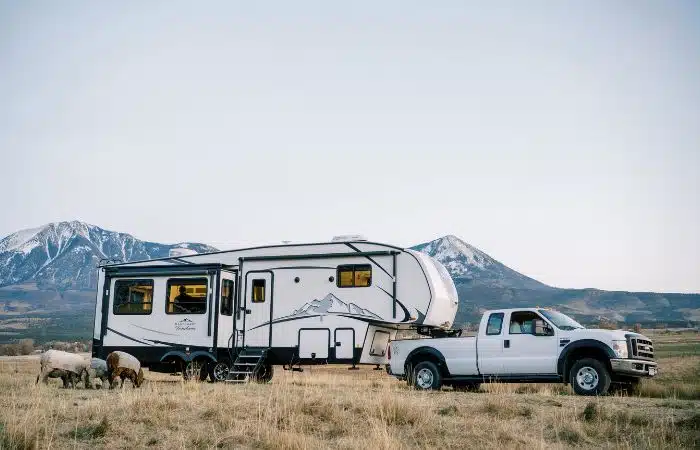
Our rig from our recent photoshoot for the cover of Harvest Host’s Roads & Stays Magazine
You can read more about our new-to-us RV setup with the fifth wheel trailer and truck – as well the Class C RV we traveled in for the two years prior – in these blog posts below.
Related:

Marc did all of the driving on this Arizona RV trip, with Julie and Sunny as co-pilots
How many miles did we drive?
Let’s start with distance. On this Arizona RV trip, we drove our truck 3,200 miles. Approximately half of those – around 1,600 miles – were towing the trailer. But as mentioned above, if we drove directly home to Colorado, that would have added another 650 miles (towing).
On our California RV trip, we drove our RV around 1,700 miles, plus our Jeep for about 2,900 miles. That added up to a combined 4,600 miles.
Our RV trip to Florida and beyond was around 8,500 miles. Marc spent over 200 hours behind the wheel on that RV trip. That’s equal to 5 full-time work weeks! So unless you’re retired or on vacation, that’s something to keep in mind!
To offer some perspective, in our full-time RV life and travels, we typically drove 8,000–10,000 miles annually with our Class A motorhome. Plus around 11,000 miles on average in our towed vehicle. So, all up, we averaged around 20,000 miles per year, with both vehicles, while traveling the country! Not bad!
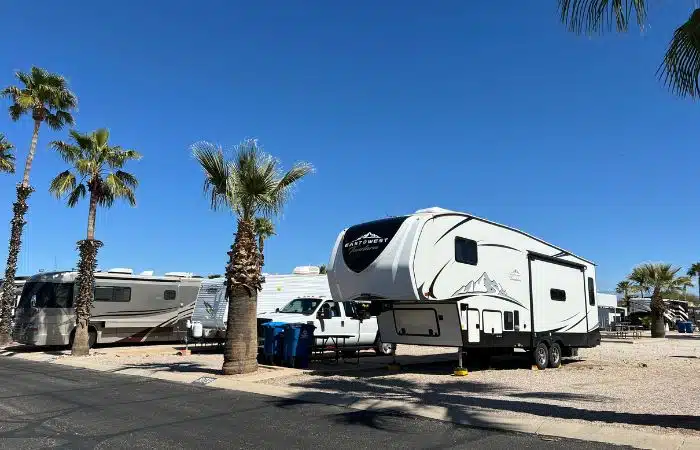
Our RV site at Voyager RV Resort in Tucson, Arizona
Winter Arizona RV Trip Stats
Let’s take a quick look at the overall stats from this Arizona RV trip:
- States visited: 4
- Miles traveled: 3,200 (1,600 of those were towing the RV)
- Average miles per gallon: 9
- Nights stayed: 111 (a combination of Thousand Trails; Private RV parks; Boondocking; And Staying with friends/Moochdocking)
- How long in each state: 73 nights in Arizona, 38 nights in California, one night in Utah, and one night in Nevada

Let’s take a quick look at the overall stats from our California RV trip the year prior:
- States visited: 4
- Combined Miles traveled: 4,600
- Average miles per gallon for RV: 14
- Average miles per gallon for Jeep: 20 (much lower than our usual mid 20s)
- Nights stayed: 63 (a combination of Thousand Trails; Private RV parks; National Park, and County Park; Staying with Family)
- How long in each state: 60 nights in California, two nights in Utah, and one night in Nevada
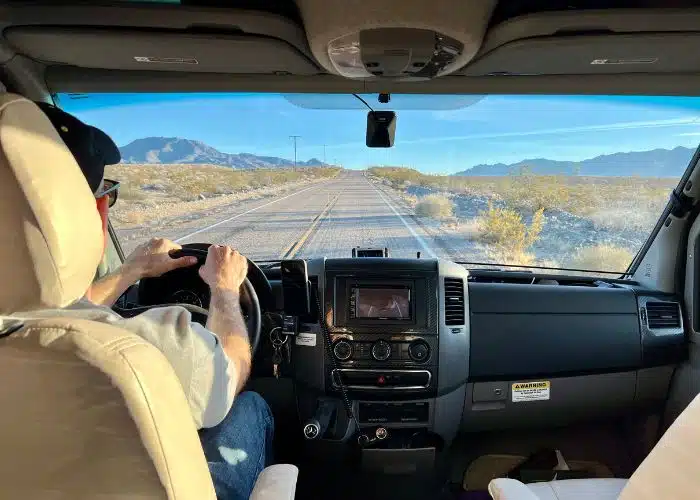
And here are the same stats from our RV trip to Florida:
- States visited: 16
- Miles traveled: 8,500 approximately
- Average miles per gallon in the Class C: 14.4
- Nights stayed: 101 (at Thousand Trails; Private RV parks; National, State, City, and COE parks; Boondocking/driveway surfing; Harvest Hosts, etc)
- How long in each state: 65 nights in Florida, 9 nights in South Carolina,
8 nights in Arizona; the remaining 13 states were three nights or less.
Sign up for our email newsletter with the latest RV park reviews, news and updates.

Our RV site at Thousand Trails Oasis RV Resort near Palm Springs

Where Did We Stay On Our Arizona RV Trip?
During this Arizona RV trip, our goal was to enjoy a much slower travel pace to immerse ourselves in the areas and reduce travel and set-up time. Especially as we are now traveling with a truck and fifth wheel!
We wanted to connect with friends and recharge our (personal) batteries. And we also intentionally carved out some quiet time and space for us to reflect on the year that was, while planning for the year ahead.
Though we love to travel and drive, from a financial perspective, we often like to spend less time towing and less money on camping fees.

Sunny is sitting at our desk, looking out the window at Meridian RV Resort, Arizona
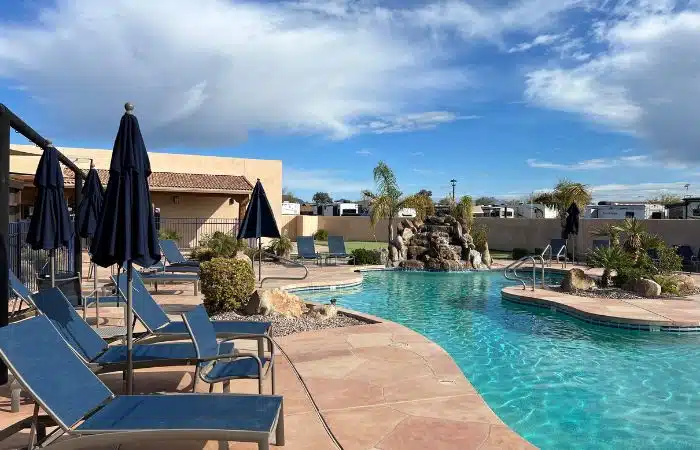
Pool area at Meridian RV Resort
Here’s a snapshot of where we stayed on our Arizona RV trip
We stayed 111 nights in total on the winter leg of our trip. Of these, 73 nights were spent in Arizona, 38 were in California, one was in Utah, and one was in Nevada.
To maximize our cost savings, we spent most of our time in our Thousand Trails membership parks. Bonus: one of us turned 55 in January! This allowed us to spend more time in the many 55+ “Age Qualified” parks within Thousand Trails’ network.
Here’s an overview of where we stayed.
- Thousand Trails: 77 nights in (Thousand Trails Palm Springs, Palm Springs Oasis RV Resort, Araby Acres, Mesa Verde, Meridian, Viewpoint, and Voyager RV Resorts.
- Private RV Parks and other paid stays: 19 nights in 3 parks (Love’s RV Stop in UT, Harvest Hosts in Henderson, NV, Catalina Spa RV Resort).
- Boondocking/Moochdocking: 15 nights
- Read Article: All About Thousand Trails in Arizona: 22 RV Parks
- Read Article: All About Thousand Trails in California: 25 RV Parks
Variable costs
Like the previous year, most of our camping fees were spent at just a few RV parks. Our nights in privately owned parks added up to only $500. Technically, seven of our ten nights at Catalina Spa RV Resort were hosted by the resort, as they invited us back to show us their improvements since our last stay. And we paid extra to stay longer. But for the purpose of keeping this information relevant to you, our readers, we based the cost on the “50% off retail price” using our Passport America membership. This pays for itself so quickly!
Fortunately, the majority of our stays had no nightly fee, with 77 nights spent in the Thousand Trails network. But, seven of our nights in the Thousand Trails network were at Viewpoint RV Resort. As one of their premium RV Resorts within the Trails Collection, we had to pay $20/night plus tax, which came to $159. Plus we had to factor in the monthly dues of $86 for our Thousand Trails membership. And then, of course, for the 15 nights of boondocking we paid no nightly fee. More details on our costs broken down below.


Sunny is living his best RV life! So cute… right?

Our Jeep and previous Class C RV at Joshua Tree National Park in California
Comparison to our California RV winter trip
Last winter, we stayed out 63 nights all up. Of those, 60 nights were in California, two nights in Utah, and one in Nevada. Again, to maximize cost savings, we spent most of our time in our Thousand Trails membership parks. Most of our California RV trip was spent in and around the Palm Springs area.
- Thousand Trails: 57 nights in 4 parks in California – at Thousand Trails Palm Springs, Palm Springs Oasis RV Resort, Pacific Dunes Ranch, and Marina Dunes RV Resort
- Private RV Parks: 3 nights in 3 parks – at Oasis Las Vegas, Nevada, KOA Green River, Utah, and Jojoba Hills SKP RV Resort, California
- National Park: 1 night boondocking at Joshua Tree National Park Belle Campground
- County Park: 1 night boondocking Faria Beach Park near Ventura, California
- One night at a family member’s house in Sacramento, CA
Varied costs
Again, most of our camping fees were spent at just a few RV parks. The lowest we paid was $15 for a boondocking spot at Joshua Tree National Park’s Belle Campground. The most we paid was almost $100 for a night at Oasis Las Vegas, and we didn’t even get to use the pool or hot tub! A few others we paid $50-$60 each.
And fortunately, the majority of campgrounds had no nightly fee, with 52 nights spent at Thousand Trails Palm Springs (this actually cost us a total of $29 as we used our bonus week extension for a total of 4-weeks in December, and another couple weeks in January), plus Palms Springs Oasis RV Resort.
Related:

Comparison to our RV trip to Florida for winter
On this trip, we stayed out for 101 nights all up. 65 nights in Florida; 9 nights in South Carolina; 8 nights in Arizona; and 3 nights or less in the remaining 13 states.
- Thousand Trails: 33 nights in 6 parks and three states – Space Coast, Sunshine Key, Gulf Air, and Crystal River in Florida. Mesa Spirit in AZ; Las Vegas in NV. Check out 40+ Thousand Trails RV Parks in Florida here
- Upscale RV Park: 16 nights at Camp Margaritaville Auburndale, FL
- Motorcoach Resort: 9 nights at Hilton Head Island Motorcoach Resort
- Other private RV Parks: 12 nights (KS, FL, TX, CA)
- National Park: 3 nights (Zion and Capital Reef NP in UT)
- State Parks: 5 nights (FL, AZ, NM)
- City Park: 3 nights (FL)
- Core of Engineers park: 1 night (TX)
- Florida RV Supershow: 5 nights at Fairgrounds (FL)
- Harvest Hosts: 4 nights (AR, MS, LA)
- Driveway Surfing/Boondocking with friends: 2 nights (FL)
- Boondocking on BLM land: 1 night in Lake Havasu, AZ
- Parking lot boondocking: 4 nights @ Grocery Store, Bass Pro, truck stops etc
- RV Repair Shop boondocking: 1 night (AZ)
- Other: 2 nights at Newell Coach HQ, OK
As you can see, most of our camping fees were spent at just 3 RV parks.
You can also see how much faster our travel pace was, with many more short stays! This is, of course, much easier with a smaller rig, and without towing.
Related:
Keep reading for more detail on our RV camping costs, plus fuel, RV costs, and our overall total trip cost.

How far in advance did we make camping reservations?
For peak times, like snowbird season, we recommend you make winter camping reservations for popular places like Arizona, California, and Florida well in advance to secure a spot.
For our most recent winter RV trip, we originally booked our two-week stay at Palm Springs Oasis California in mid-October for a December stay. Most of our other reservations were made just 30-60 days in advance. But some of our stays were booked the same day, or with only two days’ notice.

Snow-capped mountains and palm trees at Palm Springs Oasis RV Resort
What was our Travel Pace?
For our most recent RV winter trip, as mentioned above, we visited four states and drove only 1,600 miles towing the RV. The other 1,600 miles were spent doing local exploration, errands, and meeting up with friends. With only 15 locations over 111 days, we averaged over a week in every location. But some places we stayed for two while weeks, which was really nice.
By comparison, we drove five times more miles with the RV during our Florida RV trip. We visited four times as many states and averaged only three days per location. With that much faster travel pace, we were pretty exhausted by the time we returned home from the Florida trip. Hence, we decided to slow things down in the following two years.
That made those trips more relaxing and enjoyable. But also much less expensive.
It’s also worth noting that we’ve been RVing since 2014, so we have seen many of the places we visited. So with repeat visits, we often don’t feel the need to get out and about as much as we did in our earlier years. Especially as we’re still working.

Wide open road in the desert. Some may find it stressful, but we find it peaceful.
What Did It Cost: Fuel, RV Costs, Campgrounds?
So, how much did all this cost? Here’s the breakdown, by category. We share what we spent on Fuel, Repairs and Maintenance, and Campgrounds.

Fuel Cost and Fuel Economy
During this 111-day Arizona RV trip, we drove 3,200 miles. Half of those miles were towing the RV. Our truck usually gets between six and eleven miles per gallon depending on if we are towing or not, and the terrain (eg. elevation). So we used an average fuel economy of 9 miles per gallon for the trip.
Our total fuel expense was $1,433. Fortunately, fuel prices were a bit lower than the previous winter, so our average fuel price was around $4/gallon. When spread across the 111 days, our average monthly fuel cost was about $387. Much lower than the previous year.
Again, keep in mind, for a round-trip, we’d have to add 650 miles to get back home to Colorado, which would be an additional $290, for a total of around $1,722. This would naturally increase the average monthly fuel cost as well. Assuming we took 3 days to drive home, that would increase average monthly fuel cost to about $453.

Working outside at our boondocking site near Quartzsite, AZ
Comparison to California and Florida RV trips for winter
On our 63-day California RV trip, we drove 4,600 miles between the RV and Jeep. The total fuel cost was $1,494. Fuel economy was higher, but fuel prices were higher and we drove more each month. So our average monthly fuel cost for the California RV trip, including both vehicles, was $664.
On the Florida RV trip, we saw much lower average fuel prices, and spent around $2,500 in fuel over the 8,500 miles traveled. The monthly average we spent on fuel during our Florida trip was over $700.
And the Arizona RV trip was $387–$453, depending on whether you counted the return trip miles (which we didn’t do during the winter trip). Much lower!
Consider this…
Here’s a fun comparison worth sharing to give you some perspective.
When we were full-time RVing from 2014–2020, our monthly average fuel expenses were $375, traveling 12 months each year. But remember, full-time RVers don’t usually return to a home base. Our travels were mostly one-way. This can surprise many when they see how much less we spend on fuel in our full-time RV travels.
Our bigger Class A motorhomes only averaged seven to eight miles per gallon. But, our towed vehicles averaged around 27mpg, which brought the overall average down to 14mpg overall.

Sunset views from our RV site at Viewpoint RV Resort


Powering our RV with a Car Generator while in Quartzsite, AZ
What about RV Repairs and Maintenance Costs?
Now, let’s talk about RV repairs and maintenance.
We have detailed blog posts about the repairs and maintenance costs of our previous RVs in our blog post comparing full-time and part-time RVing costs.
Fortunately, our new truck and fifth wheel have had very low costs for repairs and maintenance during these first six months of ownership. During this trip we had one repair of $300 for the plumbing manifold because of an issue we had during winterization last fall (our fault). Marc also pro-actively re-caulked everything on the roof. While this didn’t need to be done, we like knowing the baseline we’re working with when it comes to RV maintenance. So it was a preventative measure, and cost around $60.
When we purchased the RV, we also took out an RV extended warranty, to cover us for any other covered repairs that may be needed over the next 4 years. This is optional, but we like the peace of mind it gives us. We’ve had an RV extended warranty on every RV we’ve owned, except our 1999 Class A diesel, as it had too many miles to qualify. But we sure would have liked having coverage on that one!
We also spent money on mods, upgrades and personalizing our Tandara fifth wheel. But these were completely optional and cosmetic, so we will cover those in a future mini RV makeover post.

What did we spend on RV campsites?
We spent a total of 111 nights away on this snowbird Arizona RV trip. Our nightly camping fees totaled $655. Which averaged out to an amazing $5.90 per night!
Our California RV trip was 63 nights and cost $463, an average of $7.35 per night.
By comparison, the RV trip to Florida was 101 nights, and our nightly camping fees came in at $4,732. A much higher average of $47 per night. But we stayed at quite a few more upscale RV resorts on that trip.
So, over these last two winters, we saved nearly $40 per night on camping fees! That is the sum of many parts. But the biggest difference hands down was our conscious decision to stay mainly at campgrounds within our Thousand Trails camping membership network. We stayed in these for the vast majority of our trip.
Note: the totals above do NOT include the annual dues we pay for our camping memberships with Thousand Trails or Harvest Hosts. We only included the nightly fees paid. We are also not including the money we spent eating at the restaurant of the Harvest Hosts location to support the host, because those were meals we would have spent money elsewhere if not staying with a host.
But we know what you’re thinking. This is not the full picture. So let’s take a quick look at what those numbers would be if we pro-rated our annual dues, and then added them to our nightly fees.

Our RV site and a sunset view from our site at Catalina Spa RV Resort

What was our nightly camping cost, including membership fees?
Here are some modified totals below if we include the pro-rated costs of those memberships into these trips.
We are basing the numbers on our current Thousand Trails membership dues, including the Trails Collection, at $86 per month. Our Harvest Hosts annual membership averages $8 per month. Our Passport America membership costs $44 for one year, for an average of $4 a month (rounded up).
So, if we add in three months of our pro-rated membership costs of $98/month, that is $294. Divide that by 111 days, and we will need to add $2.64 per night.
When adding that to our original $5.90 a night, the new average nightly cost for our recent Arizona RV trip is $8.55, including our monthly membership dues.
Previous California RV trip comparison
The previous year’s Thousand Trails dues, including our Trails Collection, were $80 monthly, or $960 a year. That’s $2.63 per night or $18.46 per week.
Considering our pro-rated membership dues of $166 for the 9 weeks, then adding that to the California trips’ $463 total camping fees, the grand total was $629. So our average nightly camping fee for the California RV trip was just $9.98 per night!
Imagine how low it would have been if we’d skipped a few of the more expensive one-night stays or stayed exclusively at Thousand Trails parks? That’s the beauty of being a member. You don’t always HAVE to stay in their parks, you can just pick and choose the ones you want! That’s what we do, and what we save helps subsidize our other, more expensive stays. As we really do enjoy variety in our RV travels.
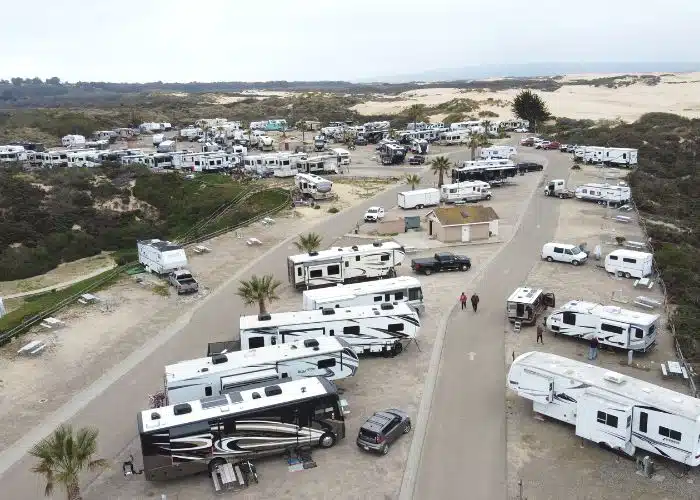
Pacific Dunes Ranch is part of the Thousand Trails Encore network, and located adjacent to some oceanside sand dunes on the California Coast
Florida RV trip nightly rate comparison
Now let’s take a look at our Florida RV trip. When adding pro-rated membership dues, it brought the total cost to $4,998 for an average nightly cost of $49.49. That is over five times the cost of our Arizona and California winter RV trip averages.
Many campgrounds easily average $40-60 a night these days, and can be much more at peak times and popular locations. So we think an average nightly rate of under $10 for our Arizona and California RV trips is pretty darn impressive! Especially as we stayed at some very nice, higher-end places.

One of the pool areas at Viewpoint RV and Golf Resort in Mesa, Arizona
How low can it go? Doing this trip on a tighter budget
Of course, if saving money is your top priority, you could make this trip even less expensive. Simple remove the higher-priced stays and stay exclusively within the Thousand Trails network, using your camping membership.
While we consider ourselves to be budget conscious, we also like to splurge every now and then, as you’ve seen from the many upscale parks we’ve enjoyed. If we were entirely focused on costs, we believe we could bring our nightly camping cost down to around $6 per night. And that’s pretty hard to beat! especially if you enjoy the creature comforts and convenience of campsites with electric, water and sewer hookups and amenities like pools, hot tubs and pickle ball courts! Which we do.
Thousand Trails saves us a LOT of money
If it sounds like we’re big fans of Thousand Trails, that’s because we are. Without our camping membership, we simply could not have afforded to RV full-time and travel the country extensively for over six years.
Even since buying a home base again (with a mortgage) and transitioning to part-time RV travel, we continue to get our money’s worth out of our membership, year after year. It allows us to head south and stay warm in winter for months at a time affordably. We may not be on a fixed income (yet) but we are saving for retirement.
Buying our Thousand Trails camping membership back in 2014 as RV newbies was one of the best decisions we made. As it has literally saved us thousands of dollars each year. When you do the math, as we’ve shared above – and consider with the ever-increasing cost of campgrounds – you can easily see how the savings add up fast. Which means more RVing for less!
Do your research
And while Thousand Trails has worked out well for us, we always recommend doing your homework. Spend time reading and doing your research with trusted sources to fully understand how Thousand Trails memberships work. You need to know what you’re getting into and how it fits into your travels before you buy. In our experience, those who do their due diligence are very happy with their decision and savings. As with so many things in life, it works if you work it!
If you want to learn more, we’ve written extensively about Thousand Trails over the years to help you make sense of it, and benefit, too. So we’ve included a few links below to some articles that explain Thousand Trails and their various camping memberships in further detail.

A premium waterfront site at Sunshine Key RV Resort, Florida
Related Articles:
- Is Thousand Trails Worth It? Our Comprehensive Review
- What did we spend on RV Camping over 6 Years of Full Time RVing?
- How Much Does a Thousand Trails Membership Cost?
- All Thousand Trails RV Parks in Arizona
- All Thousand Trails RV Parks in California
- The 40+ Thousand Trails RV Parks in Florida
- Get More Info and a Quote on Thousand Trail Memberships

Aerial view over Marina Dunes RV Resort near Monterey, CA
How We Saved Money on our Arizona RV Trip
Before we wrap up, let’s quickly recap how and where we saved money on this winter Arizona RV road trip. Remember, our goal was to be budget-conscious but still go out and have fun!
This was our key strategy:
- Made use of our camping memberships to save on nightly fees. Staying primarily at several Thousand Trails campgrounds saved us the most money on this trip, to the tune of thousands of dollars. But we also used Harvest Hosts and Passport America for a few nights here and there.
- Chose a much closer destination. By simply not driving as far, we saved money on fuel, as we only drove 3,200 miles on this trip. Our previous years were 4,600 and 8,500 miles, which obviously costs more. Plus, fewer miles means more time between RV and truck service intervals!
- Slower travel pace. Moving less often saved us time and money. And longer stays generally means lower average nightly costs. Less time behind the wheel meant more time for relaxation, play, and work. And the time savings from not breaking camp as often allowed us to settle in and save money in other ways, like not eating out as often.
- Ate budget-friendly meals. These days, we prefer to make most of our meals in our RV because it’s healthier and more convenient. But of course, it ends up being cheaper, too.

Marc and Sunny at an overlook on a dog approved trail in Saguaro National Park

Marc and Julie with bikes at the end of one of the many wonderful bike trails in Tucson
Related:
- Is Thousand Trails Worth It? Our Comprehensive Review
- Costs of RVing – Full-time vs Part-time
- Get Discount Diesel Fuel with this Card (free to apply, no credit check)
- Get More Info and a Free Quote on Thousand Trails Memberships
- The Real Costs of RV Ownership after Six Years
- Learn more with our bestselling books Living the RV Life and RV Hacks
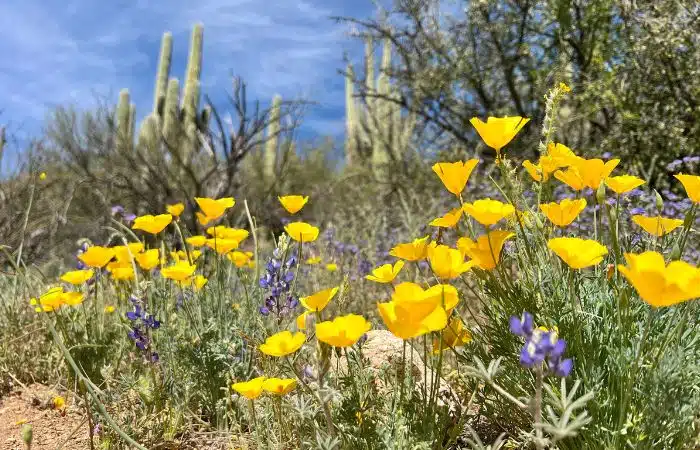
Beautiful flowers blooming among the cacti near Tucson, Arizona
Average Nightly Cost of Our Arizona RV Trip
Let’s now calculate the total costs of our winter Arizona RV trip, including fuel and campgrounds. We divided this by 111 to get the daily average for each category, then totaled, rounding up to the nearest dollar.
We did not include RV repairs and maintenance costs, as we don’t consider those to be travel costs as much as an RV ownership cost.
Fuel Expenses: Average $13 a day
We spent around $1,433 in fuel on this Arizona RV trip.
During our California and Florida RV trips, we averaged $24.50 a day. So this winter, we almost halved the daily average of the two years prior. This was largely due to a much slower travel pace, and less distance traveled. Lower fuel prices helped too.
Campground Fees: Average $9 a day
During the 111 days of this Arizona RV trip, we spent $1,035 on campground fees. That averages out to only $9 a day, including the monthly membership fees.
As mentioned above, our California RV trip average was around $10 a night. So, the two-trip average is a little over $9.50 per night.
This number was dramatically lower than the Florida trip average of almost $50 a night! Where you choose to stay really adds up.

Amazing and HUGE bike themed mural in Tucson. Spot Marc and Sunny for scale!
Total RVing-related costs: $22 a day
Our average daily fuel and campground fees cost around $22, which means we handily beat last year’s average of $34 per day by more than a third. And we blew away the Florida RV trip daily average of $72 a day!
Of course, these calculations do not include food or entertainment, which are both highly personal, variable expenses. Remember, you’d also be spending money on food, entertainment, and fuel, even if you stayed home. But that wouldn’t be nearly as much fun, would it!?
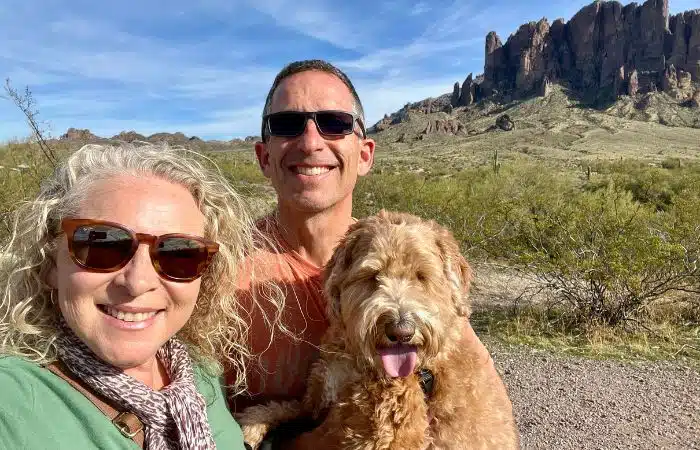
Hiking in Lost Dutchman State Park in Apache Junction, Arizona
Value of our Arizona RV Trip – Was it Worth it?
Absolutely! While we love many forms of travel, this is where RVing can be hard to beat. How else could you spend $22 a day for two people, compared to air travel, hotels or Airbnb. And maybe even a rental car for a sixteen-week winter getaway? Of course, one we can’t put a price on is being able to bring our dog, Sunny, along to share the adventures!
Yep, it can be amazing value, really. Especially when you consider all the freedom and flexibility of having your home on wheels with you, everywhere you go.

But remember…
Of course, this isn’t the FULL picture. You also need to take into account the cost of RV ownership as well. Or, if you prefer, you can also rent an RV, like we did on another RV trip to Florida. Some RV resorts even have RVs, cabins, or tiny homes you can stay in, so you can still enjoy the amenities and benefits of the RV lifestyle! It’s great to have options!
As always, if you’re considering the RV lifestyle, do your research! Plan, put together a budget, and figure out creative ways to make your RV and travel dreams a reality.
We’ve got loads more articles and free resources here on our website. So feel free to browse and use the search tool, too. We’ve also included some of our most popular and useful posts at the bottom of this article.
We know this was a lot of information. But we hope that the detail we have shared in this report helps you budget, prepare, and plan your next RV road trip. And if you think this article, or any of the other posts we mentioned, would be helpful to a friend, please feel free to share!

Summary Recap and What's Next
We had a fantastic time on our winter Arizona RV trip. Aside from enjoying fun in the sun, it was awesome to connect with our RV community, and meet up with friends. We got to avoid the coldest part of the Colorado winter, while staying warm and exploring the desert. Double-win!
Now for the second half of this trip. Which took us to Texas for the 2024 total solar eclipse. Spoiler alert…. despite a cloudy morning, at the last minute, we got to see all of totality in Del Rio, Texas! See where we stopped, where we stayed, and what we saw along the way, in the reels, stories and posts shared on our social media accounts, mainly Facebook and Instagram.
Until next time, happy travels!

Author Bio: Marc and Julie Bennett
Since 2014, Marc and Julie have been living, working, and traveling around North America in multiple RVs, sharing their experiences to help and inspire others. They love hiking, biking, and exploring with their pup Sunny. And co-authored two bestselling books "RV Hacks: 400+ Ways to Make Life on the Road Easier, Safer, and More Fun!" plus "Living the RV Life: Your Ultimate Guide to Life on the Road". They also run RVLove.com.
Keep up with us and our content
You can keep up with us on Instagram, Facebook, Twitter, and through posts here on our website RVLove.com. We invite you to sign up for our regular email updates. And, of course, you’ll learn a ton more in our bestselling books: Living the RV Life: Your Ultimate Guide to Life on the Road and RV Hacks: 400+ Ways to Make Life on the Road Easier, Safer, and More Fun.

What are your travel plans?
Tell us where you went this past winter, and share your travel plans for the coming year in the comments section below!

Relaxing (and working some too) poolside at Viewpoint RV Resort in Mesa, Arizona
Links To Related Videos and Blog Posts
We have a ton of content related to this article. From campground reviews to more detailed blog posts on specific topics to deepen your learning, help you save money, avoid mistakes, and have more RV travel fun. Check them out!
Related blog posts:
Sign up for our email newsletter with the latest RV park reviews, news and updates.
More RV Travel Content
Want to check out more of our RV Travel related content? Hover over each image to see the title and episode name.

How Much? Arizona Winter RV Road Trip Stats and Comparison
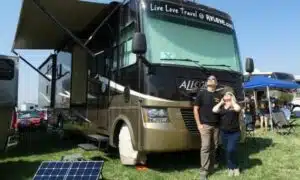
Solar Eclipse of April 8 2024 Path: Why and Where You Should Go!

See the Annular Solar Eclipse, Camp at EclipseFest23: Multi-Day Festival in October

The Next Solar Eclipses In The US: 2023 and 2024

Canadian Border Crossing Tips With Your RV

Our California RV Trip Recap And Cost Comparison

Busting 5 Common RV Camping Myths With Proof!

Save Money On Fuel With These 7 Top Tips

Our 8,500 Mile RV Trip to Florida and Beyond

Albuquerque Balloon Fiesta Guide (2023 update)

Is Virginia for Lovers? Finding Love – RV style

Our Top 5 Highlights after 5 Years of Full-Time RVing

Top Tips for RVing at Albuquerque International Balloon Fiesta

Your Guide to a Great Time at Albuquerque International Balloon Fiesta

17 Inspiring National Parks You Must Visit
GOT COMMENTS OR QUESTIONS?
We would love to hear from you. Drop us a note in the comments section below.


6 thoughts on “How Much? Arizona Winter RV Road Trip Stats and Comparison”
Have you thought about putting your expenses in an infographic chart on the website? It would be much easier to read. Nonetheless, that was great and helpful information, thanks for sharing. Nice and a bit surprising to see you enjoyed life for $22/day for 2. You can’t beat it. ❤️
That is a great idea! We have done that in the past but yes we should do that again for this trip – and the previous two years! Thanks for the nudge / suggestion! So happy you found the information helpful.
Thanks for all of the details and comparisons! Very useful information!
My husband, our dog and I were away from our home in Oregon for 28 nights between mid-February and mid-March. We spent a total of 21 nights in California and 7 nights in Arizona. We drove a total of about 4,300 miles in our Ford F250 truck, most of which was driven with our Lance camper on the back of it. (We also own a 35-foot Class A National Sea Breeze motorhome.) We primarily stayed at state parks and KOA campgrounds. We visited four national parks, saw a lot of beautiful wildflowers and toured part of Route 66. It was an awesome trip!
That’s fantastic! So glad you had a great trip – you have the best of both worlds with the bigger and smaller rig! How lucky we are to live and travel this way, huh? Thank you so much for sharing the stats frm oyur own trip! Safe and happy travels! Glad you enjoyed the post. – J
This was a great article. I appreciate so much how you keep things real. No hidden costs, no-nonsense reporting. You explain that this works for your lifestyle but not necessarily for all.
I look forward to reading more of your posts.
Happy Travels.
Thanks Kelley! Glad you enjoyed it…. hope you are doing well! Happy Travels!